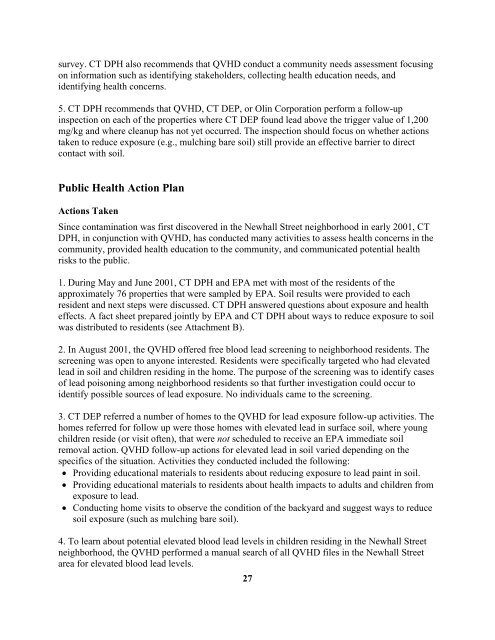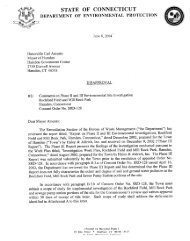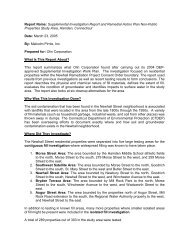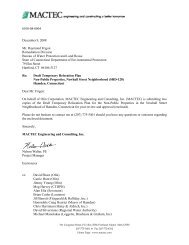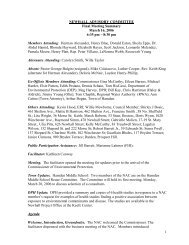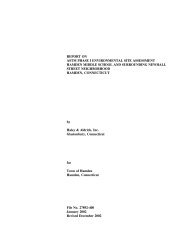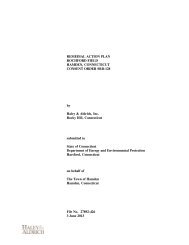Main Report - Newhall Remediation Project
Main Report - Newhall Remediation Project
Main Report - Newhall Remediation Project
- No tags were found...
Create successful ePaper yourself
Turn your PDF publications into a flip-book with our unique Google optimized e-Paper software.
survey. CT DPH also recommends that QVHD conduct a community needs assessment focusingon information such as identifying stakeholders, collecting health education needs, andidentifying health concerns.5. CT DPH recommends that QVHD, CT DEP, or Olin Corporation perform a follow-upinspection on each of the properties where CT DEP found lead above the trigger value of 1,200mg/kg and where cleanup has not yet occurred. The inspection should focus on whether actionstaken to reduce exposure (e.g., mulching bare soil) still provide an effective barrier to directcontact with soil.Public Health Action PlanActions TakenSince contamination was first discovered in the <strong>Newhall</strong> Street neighborhood in early 2001, CTDPH, in conjunction with QVHD, has conducted many activities to assess health concerns in thecommunity, provided health education to the community, and communicated potential healthrisks to the public.1. During May and June 2001, CT DPH and EPA met with most of the residents of theapproximately 76 properties that were sampled by EPA. Soil results were provided to eachresident and next steps were discussed. CT DPH answered questions about exposure and healtheffects. A fact sheet prepared jointly by EPA and CT DPH about ways to reduce exposure to soilwas distributed to residents (see Attachment B).2. In August 2001, the QVHD offered free blood lead screening to neighborhood residents. Thescreening was open to anyone interested. Residents were specifically targeted who had elevatedlead in soil and children residing in the home. The purpose of the screening was to identify casesof lead poisoning among neighborhood residents so that further investigation could occur toidentify possible sources of lead exposure. No individuals came to the screening.3. CT DEP referred a number of homes to the QVHD for lead exposure follow-up activities. Thehomes referred for follow up were those homes with elevated lead in surface soil, where youngchildren reside (or visit often), that were not scheduled to receive an EPA immediate soilremoval action. QVHD follow-up actions for elevated lead in soil varied depending on thespecifics of the situation. Activities they conducted included the following:• Providing educational materials to residents about reducing exposure to lead paint in soil.• Providing educational materials to residents about health impacts to adults and children fromexposure to lead.• Conducting home visits to observe the condition of the backyard and suggest ways to reducesoil exposure (such as mulching bare soil).4. To learn about potential elevated blood lead levels in children residing in the <strong>Newhall</strong> Streetneighborhood, the QVHD performed a manual search of all QVHD files in the <strong>Newhall</strong> Streetarea for elevated blood lead levels.27


